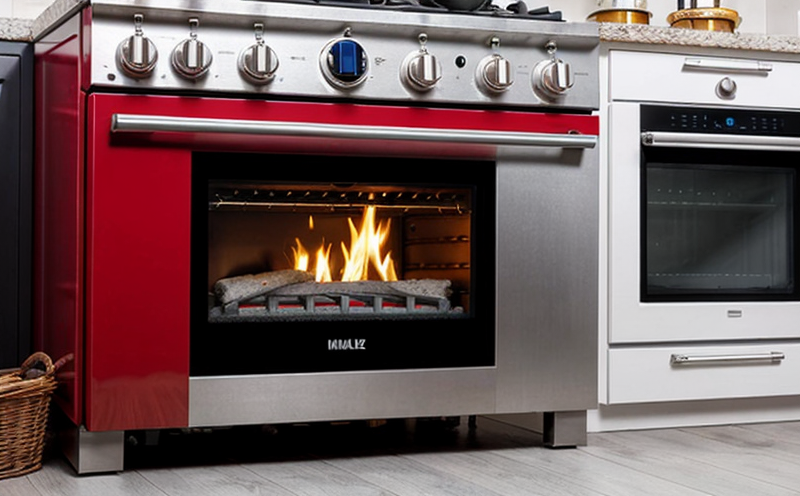ASTM D3801 Vertical Burn Test of Appliance Plastics
The ASTM D3801 Vertical Burn Test is a critical procedure used to evaluate the fire safety characteristics of plastics commonly found in household appliances. This test assesses how well the plastic will resist ignition and continue burning when exposed to a flame. The standard is particularly relevant for materials that are expected to remain functional even under extreme heat conditions, such as those found in cooktops, ovens, and other heating devices.
The ASTM D3801 test involves placing a small piece of the plastic specimen vertically into an apparatus designed to deliver a controlled flame. The duration and intensity of the flame are carefully regulated according to the standard's parameters. Afterward, observers measure both the time it takes for the flame to extinguish on its own and any after-flame behavior. This information helps determine whether the material meets the required fire safety standards.
The test is crucial because it ensures that appliances do not pose a significant fire hazard when exposed to flames, which can occur during normal use or in case of malfunctions. By adhering to this standard, manufacturers can demonstrate their commitment to producing safe and reliable products.
One key aspect of the ASTM D3801 test is its ability to simulate real-world conditions that might cause a fire outbreak. For instance, it replicates the scenario where an appliance is accidentally left on for too long or where a user mishandles a component. Understanding these scenarios allows manufacturers to make informed decisions about material selection and design improvements.
The procedure also includes detailed specimen preparation guidelines to ensure consistency across different batches of materials. Proper sample cutting ensures that each test run provides accurate results, which is essential for maintaining the integrity of the testing process.
Another important factor in ASTM D3801 testing is the instrumentation used. The apparatus must be capable of delivering a consistent and controlled flame at specified temperatures and durations. This precision helps produce reliable data that can be relied upon by regulatory bodies and customers alike.
The acceptance criteria for this test are stringent, designed to protect users from potential risks associated with flammable materials in appliances. Meeting these criteria ensures compliance with international standards like ISO 9772-1:2018 and ASTM E648-19, which further reinforces the importance of this testing procedure.
| Industry Applications |
|---|
| Cooktops and stoves |
| Ovens |
| Toaster ovens |
| Dishwashers |
| Refrigerators with heating elements |
| Microwaves with exposed plastics |
| Space heaters |
| Other home appliances using exposed plastic parts |
The ASTM D3801 test is essential for ensuring that the plastics used in these appliances meet stringent fire safety requirements. By conducting this test, manufacturers can verify that their products are safe and reliable, thereby protecting consumers from potential hazards.
Why Choose This Test
Selecting the ASTM D3801 Vertical Burn Test is a wise choice for several reasons. Firstly, it provides manufacturers with valuable insights into how their materials will behave under fire conditions. This knowledge can guide them in selecting more appropriate and safer materials for use in household appliances.
Secondly, compliance with this test ensures that products meet the necessary safety standards set by regulatory bodies. By adhering to these standards, companies can avoid legal issues and maintain a good reputation among consumers who trust them to produce safe products.
Thirdly, conducting ASTM D3801 tests allows for continuous improvement in product design and manufacturing processes. Regular testing helps identify areas where improvements can be made, leading to safer and more efficient appliances.
Lastly, the test results provide a benchmark against which future products can be compared, ensuring consistent quality across all items produced by the company. This consistency is crucial for maintaining consumer confidence and trust in brand loyalty.
Environmental and Sustainability Contributions
The ASTM D3801 Vertical Burn Test plays a significant role in promoting environmental sustainability through its emphasis on reducing fire risks associated with household appliances. By ensuring that the plastics used in these devices meet strict fire safety standards, this test helps prevent accidental fires caused by faulty or unsafe materials.
Preventing such incidents not only protects people's lives but also minimizes property damage and potential loss of life. Additionally, it reduces the need for costly emergency responses and medical treatments that could arise from such accidents.
Incorporating fire-resistant materials into appliance designs contributes to a safer environment by reducing the likelihood of fires breaking out in homes. This precautionary approach fosters a culture of safety among consumers who appreciate the efforts made by manufacturers towards creating safer products.
The use of compliant materials also supports broader sustainability goals by promoting responsible resource management practices throughout the supply chain. By choosing fire-resistant plastics that comply with ASTM D3801, companies demonstrate their commitment to sustainable development principles aimed at reducing waste and conserving natural resources.





